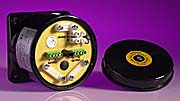A
attractivebrunette
I have a toroidal transformer to be use for 12V track lighting.
The transformer has the primary blue and brown wires.
The four 12V wires are as follows:
SEC: 0-12V RED YELLOW
0-12V BLACK GREY
Which of these wires do I join before connecting to each of the two 12V tracks?
The transformer has the primary blue and brown wires.
The four 12V wires are as follows:
SEC: 0-12V RED YELLOW
0-12V BLACK GREY
Which of these wires do I join before connecting to each of the two 12V tracks?




